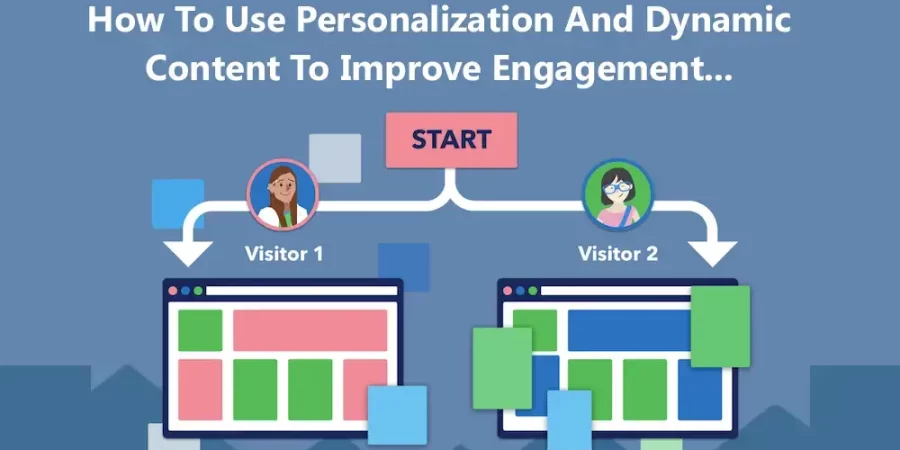Beginners Guide: How To Use Personalization And Dynamic Content To Improve Engagement?
Personalization and dynamic content are two powerful tools that can be used to improve engagement with your audience.
By tailoring your messaging and content to the unique needs and interests of your target audience, you can create a more meaningful and personalized experience that will keep them coming back for more.
In this article, we will explore the benefits of personalization and dynamic content and provide tips on how to use them to improve engagement.
1: The benefits of personalization
Personalization is the process of tailoring your messaging and content to the unique needs and interests of your target audience. By doing so, you can create a more meaningful and personalized experience that will keep them engaged with your brand. Some of the key benefits of personalization include:
- Increased engagement: Personalized content is more likely to be read and shared, which can lead to higher engagement rates.
- Better customer retention: Personalized content can help to build stronger relationships with your audience, which can lead to increased customer loyalty and retention.
- Improved ROI: Personalized content is more likely to be relevant and useful to your audience, which can lead to better conversion rates and improved ROI.
2: The benefits of dynamic content
Dynamic content is content that is generated and delivered in real-time based on the preferences and behavior of your audience. This allows you to deliver personalized content that is tailored to the unique needs and interests of your target audience. Some of the key benefits of dynamic content include:
- Increased relevance: Dynamic content is more likely to be relevant and useful to your audience, which can lead to higher engagement rates.
- Better targeting: Dynamic content allows you to target specific segments of your audience with tailored content, which can lead to better conversion rates.
- Improved ROI: Dynamic content is more likely to be relevant and useful to your audience, which can lead to better conversion rates and improved ROI.
3: Tips for using personalization and dynamic content to improve engagement
- Segment your audience: One of the most effective ways to use personalization and dynamic content is to segment your audience into different groups based on their preferences and behavior. This allows you to deliver tailored content that is relevant and useful to each group.
- Use data to inform your personalization efforts: Personalization is most effective when it is based on data. Use data from your website, social media, and other sources to inform your personalization efforts.
- Use real-time data: Dynamic content is most effective when it is based on real-time data. Use data from your website, social media, and other sources to inform your dynamic content efforts.
- Test and refine your strategies: Personalization and dynamic content are not a one-time effort. Test different strategies and refine them based on your results.
- Incorporate personalization and dynamic content throughout your customer journey: Personalization and dynamic content should be incorporated throughout your customer journey, from the first point of contact to the post-purchase experience.
4: Personalization in email marketing
Email marketing is one of the most effective ways to use personalization to improve engagement. By sending personalized emails to your audience, you can increase open and click-through rates, as well as conversion rates. Here are some tips for using personalization in email marketing:
- Use the recipient’s name in the subject line and body of the email.
- Segment your email list based on demographics, behavior, and other data.
- Send personalized product or content recommendations based on the recipient’s browsing or purchase history.
- Use dynamic content to show different images or offers based on the recipient’s location or browsing history.
5: Personalization in website and mobile app design
Personalization can also be used in website and mobile app design to improve engagement. By tailoring the layout, content, and functionality of your website or app to the unique needs and interests of your audience, you can create a more engaging and personalized experience. Here are some tips for using personalization in website and mobile app design:
- Use dynamic content to show different images, offers, or functionality based on the user’s location or browsing history.
- Use personalization to create a unique and personalized homepage or landing page for each user.
- Use personalization to create personalized product or content recommendations based on the user’s browsing or purchase history.
- Use personalization to create personalized call-to-action buttons or forms based on the user’s browsing or purchase history.
6: Personalization in social media
Social media is another powerful tool that can be used to improve engagement through personalization. By tailoring your content and messaging to the unique needs and interests of your audience, you can create a more engaging and personalized experience. Here are some tips for using personalization in social media:
- Use personalization to create targeted ads and sponsored posts.
- Use personalization to create personalized content and messaging based on the user’s interests and behavior.
- Use personalization to create personalized product or content recommendations based on the user’s browsing or purchase history.
- Use personalization to create personalized call-to-action buttons or forms based on the user’s browsing or purchase history.
7: Personalization in search engine optimization (SEO)
Personalization can also be used in search engine optimization (SEO) to improve engagement. By tailoring your website and content to the unique needs and interests of your audience, you can improve your search engine ranking and drive more traffic to your website. Here are some tips for using personalization in SEO:
- Use keywords that are relevant to the user’s search query and interests.
- Use personalization to create targeted landing pages for different segments of your audience.
- Use personalization to create personalized product or content recommendations based on the user’s browsing or purchase history.
- Use personalization to create personalized meta descriptions, title tags and alt tags for images based on the user’s browsing or purchase history.
8: Personalization in customer service
Personalization can also be used in customer service to improve engagement. By tailoring your customer service interactions to the unique needs and interests of your customers, you can create a more engaging and personalized experience. Here are some tips for using personalization in customer service:
- Use personalization to create personalized welcome messages and greetings when customers contact customer service.
- Use personalization to create personalized responses based on the customer’s history and purchase history.
- Use personalization to create personalized follow-up messages and offers based on the customer’s history and purchase history.
- Use personalization to create personalized thank you messages and offers based on the customer’s history and purchase history.
9: Personalization in mobile push notifications
Personalization can also be used in mobile push notifications to improve engagement. By tailoring your mobile push notifications to the unique needs and interests of your customers, you can create a more engaging and personalized experience. Here are some tips for using personalization in mobile push notifications:
- Use personalization to create targeted mobile push notifications for different segments of your audience.
- Use personalization to create personalized product or content recommendations based on the user’s browsing or purchase history.
- Use personalization to create personalized call-to-action buttons or forms based on the user’s browsing or purchase history.
- Use personalization to create personalized messages and offers based on the user’s location, time of day, and other factors.
Here are some key takeaways from the article on “How to use personalization and dynamic content to improve engagement”:
- Personalization is the process of tailoring your messaging and content to the unique needs and interests of your target audience. By doing so, you can create a more meaningful and personalized experience that will keep them engaged with your brand.
- Dynamic content is content that is generated and delivered in real-time based on the preferences and behavior of your audience. This allows you to deliver personalized content that is tailored to the unique needs and interests of your target audience.
- Segmenting your audience is one of the most effective ways to use personalization and dynamic content. It allows you to deliver tailored content that is relevant and useful to each group.
- Use data from your website, social media, and other sources to inform your personalization efforts.
- Test and refine your strategies for personalization and dynamic content.
- Incorporate personalization and dynamic content throughout the customer journey, from the first point of contact to the post-purchase experience.
- Personalization can be used in various ways such as in email marketing, website and mobile app design, social media, search engine optimization, customer service and mobile push notifications.
- Personalization in email marketing, use the recipient’s name, segment your email list, send personalized product or content recommendations, use dynamic content to show different images or offers based on the recipient’s location or browsing history.
- Personalization in website and mobile app design, use dynamic content to show different images, offers, or functionality based on the user’s location or browsing history, create personalized homepage, product or content recommendations, call-to-action buttons or forms based on the user’s browsing or purchase history.
- Personalization in social media, use personalization to create targeted ads and sponsored posts, personalized content and messaging based on the user’s interests and behavior, personalized product or content recommendations, personalized call-to-action buttons or forms based on the user’s browsing or purchase history.
- Personalization in search engine optimization (SEO), use keywords that are relevant to the user’s search query and interests, create targeted landing pages for different segments of your audience, personalized product or content recommendations, personalized meta descriptions, title tags and alt tags for images based on the user’s browsing or purchase history.
- Personalization in customer service, use personalization to create personalized welcome messages and greetings, personalized responses, follow-up messages and offers, thank you messages and offers based on the customer’s history and purchase history.
- Personalization in mobile push notifications, use personalization to create targeted mobile push notifications for different segments of your audience, personalized product or content recommendations, personalized call-to-action buttons or forms based on the user’s browsing or purchase history, personalized messages and offers based on the user’s location, time of day, and other factors.
In conclusion, personalization and dynamic content are powerful tools that can be leveraged to improve engagement with your target audience. By tailoring your content, messaging, and interactions to the unique needs and interests of your target audience, you can create a more meaningful and personalized experience that will keep them engaged with your brand.
Personalization can be used in various ways such as in email marketing, website and mobile app design, social media, search engine optimization, customer service, and mobile push notifications. By incorporating personalization and dynamic content throughout the customer journey, from the first point of contact to the post-purchase experience, you can create a more personalized and engaging experience for your target audience.
Remember to segment your audience, use data to inform your personalization efforts, test and refine your strategies, and continually incorporate personalization and dynamic content to keep your audience engaged with your brand. By doing so, you can foster stronger relationships, increase customer loyalty and retention, and ultimately drive improved ROI for your business.





Leave a Reply